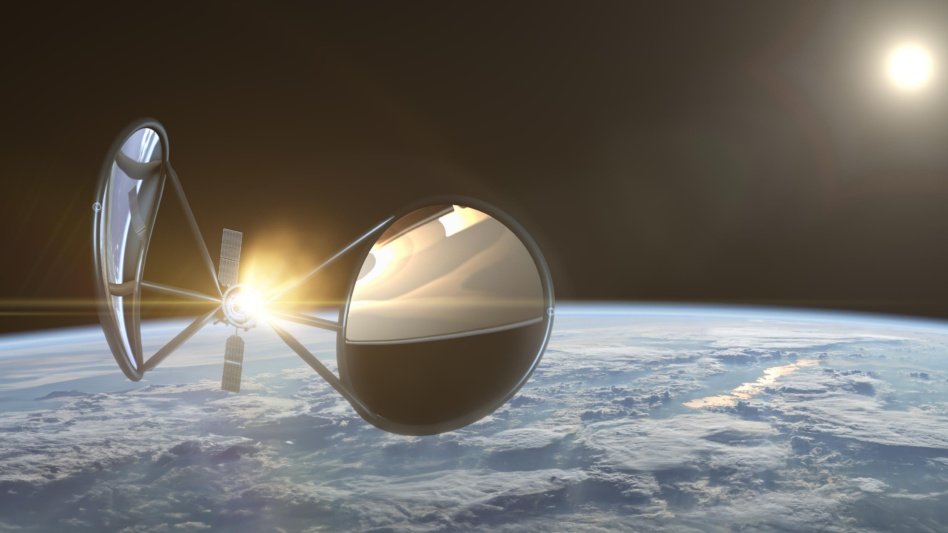Solar thermal propulsion has been a hot topic of discussion and research for future satellites in Earth’s orbit, but a new start-up, Portal Space Systems, based in Bothell, Washington, has introduced a new and innovative solar thermal propulsion (STP) technology that they promise will revolutionize the technology and how future satellites will navigate the cosmos.
Solar thermal propulsion systems combine principles from thermodynamics, material science, and optics. In simple terms, an STP system operates by collecting solar energy using large, lightweight mirrors that focus sunlight onto a compact area. This concentrated solar energy is then used to heat a propellant—often hydrogen due to its high performance characteristics—within a specialized chamber. As the propellant heats up, it expands and is expelled through a rocket nozzle, creating thrust.
The efficiency of the STP system lies in its ability to convert solar energy directly into kinetic energy, minimizing losses and maximizing the thrust generated. It sounds great on paper, but making it a reality is another issue.
Enter Jeff Thornburg, co-founder and CEO of Portal Space Systems, who brings a wealth of experience from his tenure at industry giants such as SpaceX and Amazon’s Project Kuiper.
“It’s taken me back to my SpaceX Raptor days, where we can move fast and break things, and iterate more quickly,” Thornburg told Geekwire, discussing how he and his team settled on solar thermal propulsion. “And we had a good scientific foundational base to justify our performance estimates, because of all the work that the government had done 30-plus years ago.”
While solar thermal propulsion is not new, and Thornburg’s Portal is not the only company getting into this race, the company’s “Supernova” bus system (a frame and propulsion system that can be modified to carry a load) promises to do things differently.
Their STP technology promises to enhance the maneuverability of satellites, enabling rapid orbital adjustments and deployments. This capability is crucial for a variety of applications, from managing orbital debris to deploying assets in response to global crises.
Most satellites today predominantly use electric propulsion systems for their in-space maneuvers. Electric propulsion, which includes technologies such as ion thrusters and Hall effect thrusters, is favored for its efficiency and the ability to provide a higher specific impulse compared to conventional chemical propulsion systems. The main drawback is that they are slow. Portal promises a much bigger punch at 6 kilometers per second of delta-v (the pace at which a satellite can change its velocity).
“A lot of systems are lucky if they have 200 meters per second of delta-v when they launch. Certainly most have 500 meters per second or less,” Thornburg said in an interview. “So, we’re talking about 10X the capability of existing systems. And then when you add refueling on top of that, now you’ve really got a game-changer, with multiple of these spacecraft in particular orbits servicing certain needs.”
Portal received $3 million dollars from the Pentagon’s “Tactically Responsive Space” strategy project, which is focused on developing technology that can be used for the fast deployment of space assets, as well as the Space Force.
The company promises that the Supernova satellite bus, equipped with the STP system, can perform maneuvers between different orbits in a fraction of the time required by current technologies.
“When we looked at the market, there are some companies that say, ‘We’re going to be an orbital debris company, or we’re going to go map the debris and monetize that.’ I didn’t think there’s enough real revenue long-term in any one of those distinct areas to build a business around,” Thornburg said. “But I did think that all of those businesses want more delta-v than they have capable. So, we market it as a satellite bus structure, because we can offer so many different opportunities to allow folks that are focused on their unique payload application.”
But there are challenges. Scaling production to meet the needs of various players in the space industry is no small feat. Moreover, its scaling production in material science, some of which is untested and still in the theoretical phase. The development of materials that can withstand high temperatures and the harsh space environment is critical. They need to be light, survive high levels of radiation, and be able to absorb vast amounts of heat. Future innovations in material science and thermal management are critical to overcoming these issues.
While Portal isn’t going into details regarding their tech or their plans, Thornburg said that they hope to begin running in-space tests somewhere in late 2025.
MJ Banias covers space, security, and technology with The Debrief. You can email him at mj@thedebrief.org or follow him on Twitter @mjbanias.

